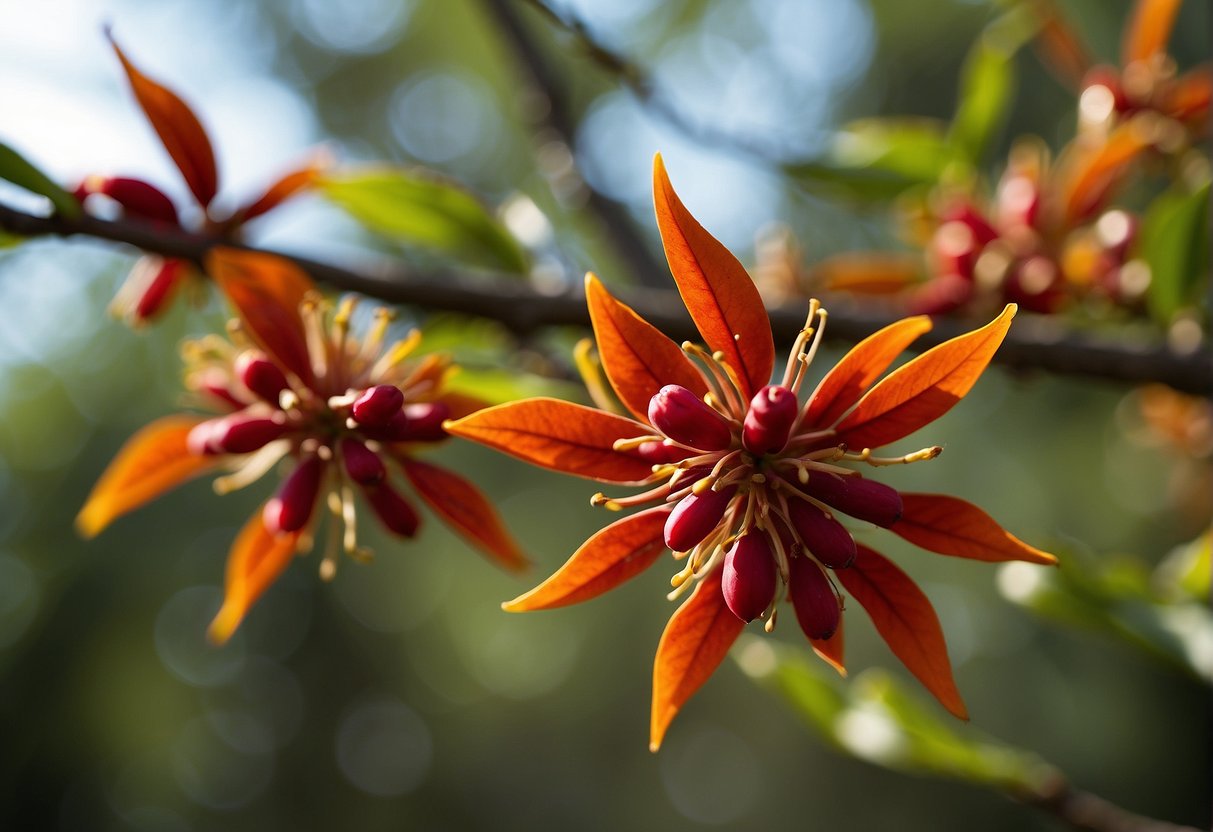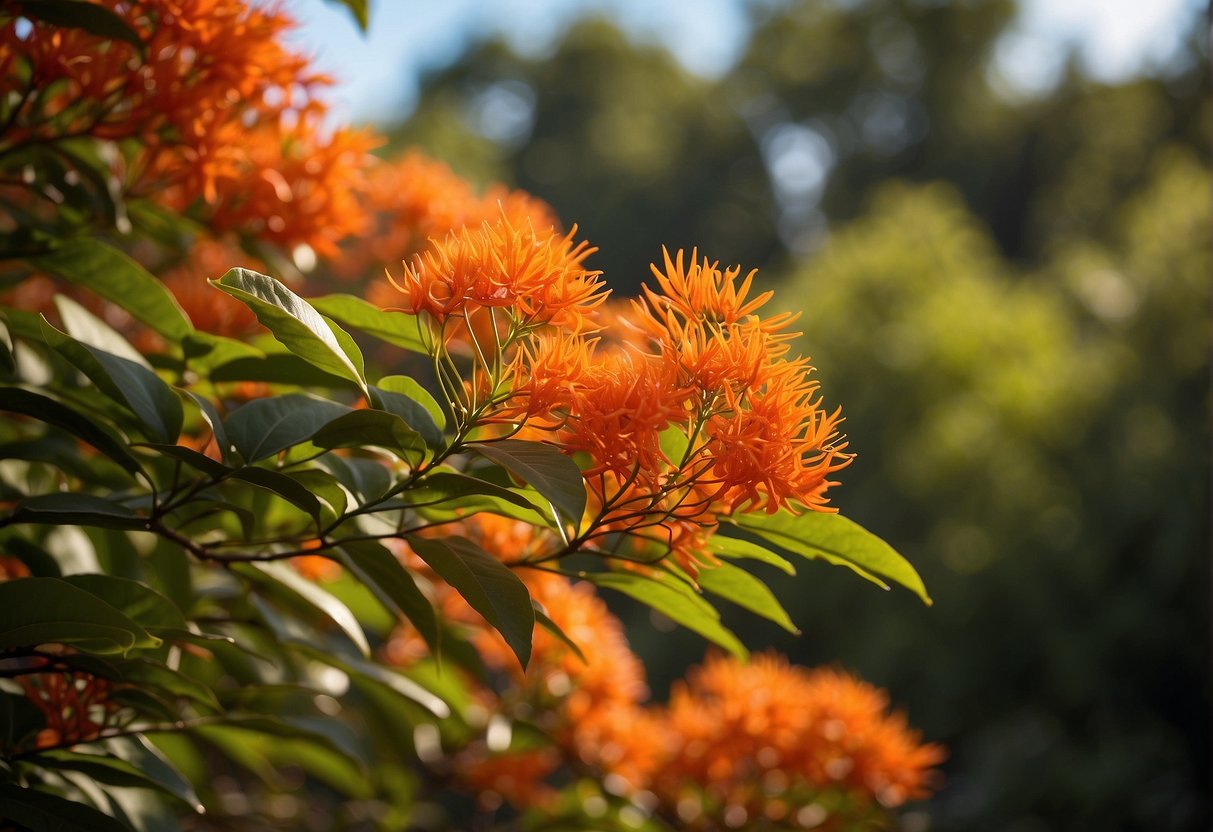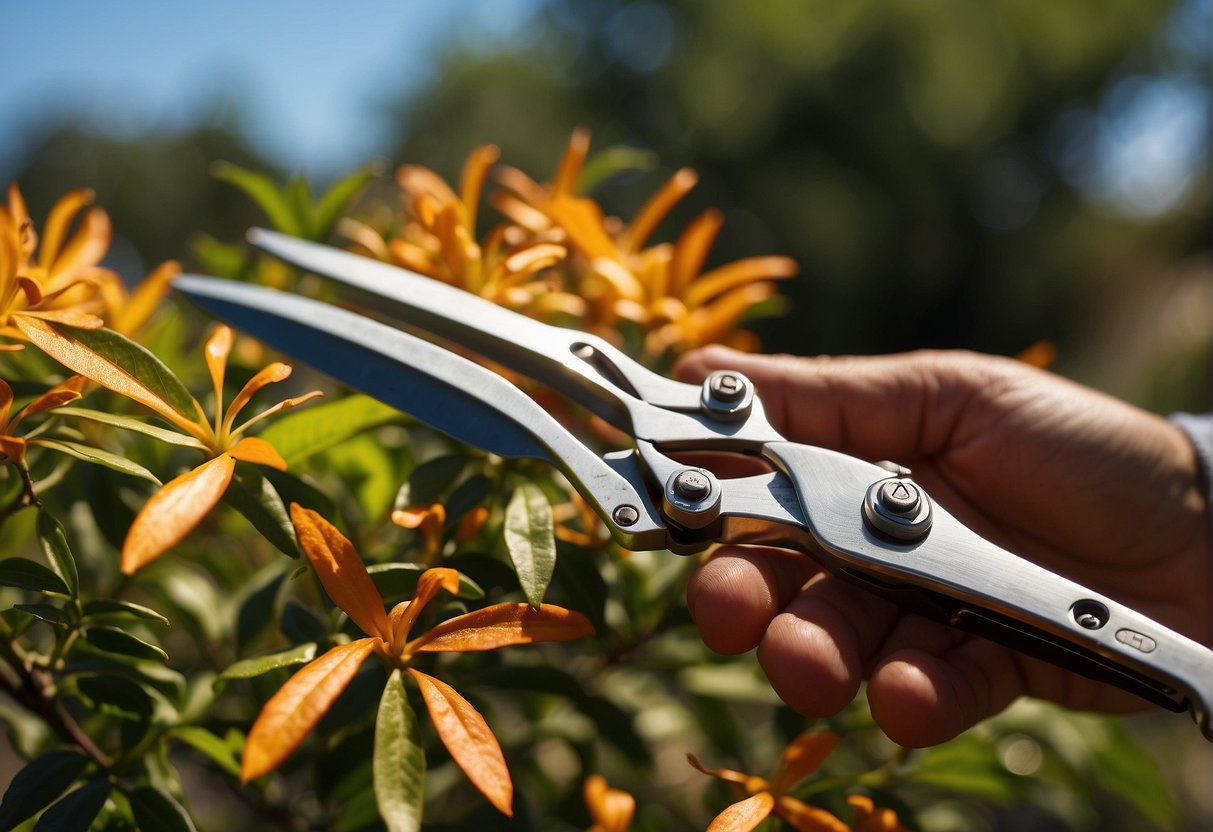How to Prune Firebush: A Step-by-Step Guide
In case you’re aiming to maintain a thriving and visually appealing firebush, pruning plays a crucial role. This activity aids in encouraging growth, eliminating branches that are either dead or infected, and tailoring the shape of the plant according to your preference. Nonetheless, if you’re new to pruning, the task might seem daunting. Within this piece, we’re set to delve into the fundamentals of pruning firebush, equipping you with the knowledge to ensure your plant remains in good health and lively.

Before we dive into the specifics of pruning, it’s important to understand the firebush plant itself. Hamelia patens, commonly known as firebush, is a perennial shrub that is native to the southern United States and parts of Mexico. It’s known for its vibrant red-orange flowers that bloom throughout the year and attract hummingbirds and butterflies. Firebush can grow up to 10 feet tall and wide, but can also be kept smaller with regular pruning. Understanding the plant’s growth habits and optimal growing conditions is key to successful pruning.
Key Takeaways
- Pruning is an essential task for keeping your firebush healthy and vibrant.
- Firebush is a perennial shrub known for its vibrant red-orange flowers.
- Understanding the plant’s growth habits and optimal growing conditions is key to successful pruning.
Understanding Firebush
Botanical Profile
Firebush (Hamelia patens var. glabra) is a flowering shrub that is native to South America, Mexico, and Central America. It is also commonly found in South Florida and Northern Florida. The plant has a long blooming period, producing vibrant red-orange tubular flowers that attract hummingbirds and butterflies. The leaves are oval-shaped and dark green, with a glossy texture.
Growth Habits
Firebush is a fast-growing shrub that can reach a height of 6 to 8 feet and a width of 4 to 6 feet. It prefers full sun but can tolerate partial shade. The plant is drought-tolerant and can grow in well-drained soil. It is also salt-tolerant and can thrive in coastal areas.
Firebush can be propagated from seeds or cuttings. The plant can be pruned to maintain its shape and size, promote bushier growth, and remove dead or diseased branches.
Regional Varieties
There are several regional varieties of firebush, each with its own unique characteristics. Some of the popular varieties include:
-
Hamelia patens var. patens: This variety is native to Mexico and has larger leaves and flowers than other varieties.
-
Hamelia patens var. glabra: This variety is native to South America and has smaller leaves and flowers than other varieties.
-
Hamelia patens var. bahamensis: This variety is native to the Bahamas and has pinkish-red flowers instead of the typical red-orange flowers.
Understanding the botanical profile, growth habits, and regional varieties of firebush is essential for successful pruning. With proper care and maintenance, firebush can add vibrant color and attract wildlife to your garden.
Optimal Growing Conditions

To ensure your firebush thrives, it’s important to provide it with the right growing conditions. Here are some key factors to consider:
Soil and Sunlight
Firebush grows best in full sun exposure, so make sure it’s planted in an area that receives at least 6 hours of direct sunlight per day. Additionally, it prefers well-drained soil that’s rich in organic matter. If your soil is heavy or clay-like, you may need to amend it with compost or sand to improve drainage.
Water and Temperature
While firebush is drought-tolerant, it still requires regular watering during the first few months after planting to help establish its root system. After that, it can be watered once a week or less, depending on the temperature and rainfall in your area. In terms of temperature, firebush can tolerate a wide range, but it prefers warm conditions. If you live in an area with cold winters, consider planting your firebush in a sheltered spot or covering it with a frost blanket during the coldest months.
Fertilization and Care
Firebush doesn’t require much fertilization, but you can give it a boost in the spring by applying a slow-release fertilizer. Be sure to follow the instructions on the package carefully, as over-fertilization can damage the plant. In terms of care, firebush is relatively low-maintenance. You can prune it in the spring to encourage bushier growth and remove any dead or damaged branches. Additionally, keep an eye out for pests like spider mites and scale insects, which can sometimes be a problem. If you notice any signs of infestation, treat the plant with an insecticidal soap or oil spray.
Pruning Basics

Pruning is an essential task for maintaining the health and appearance of your firebush. Proper pruning techniques can help promote new growth and keep the plant looking tidy. In this section, we will discuss the best time to prune, pruning goals, and the tools and techniques you will need.
Best Time to Prune
The best time to prune your firebush is in late winter or early spring before new growth begins. This is when the plant is dormant, and pruning will not harm the new growth. Avoid pruning during the fall or winter when the plant is actively growing.
Pruning Goals
The main goal of pruning your firebush is to remove dead or damaged branches and promote new growth. Regular pruning can also help control the plant’s size and shape. When pruning, make sure to cut back to a growth node to encourage new growth.
Tools and Techniques
To prune your firebush, you will need keen-edged pruning shears or loppers. Make sure your tools are clean and disinfected with alcohol or a bleach solution to prevent the spread of disease. When pruning, make clean cuts at a 45-degree angle to prevent damage to the woody tissues.
Hand trimming is the best technique for pruning firebush. Start by removing any dead or damaged branches, cutting back to a growth node. Then, thin out any crowded or crossing branches to promote new growth and airflow. Avoid pruning more than a third of the plant at once to prevent stress and damage.
In summary, pruning your firebush is essential for maintaining its health and appearance. By following the best time to prune, pruning goals, and using the proper tools and techniques, you can promote new growth and keep your firebush looking its best.
Pruning for Health
Proper pruning of your firebush is essential for maintaining its health and promoting growth. Follow these guidelines to keep your plant in top condition.
Removing Diseased Limbs
If you notice any diseased limbs on your firebush, it’s important to remove them as soon as possible to prevent the spread of disease to other parts of the plant. Cut off any branches that are discolored, wilted, or have spots on the leaves. Use sharp, clean pruning shears to make a clean cut just above a healthy bud or branch. Dispose of the diseased branches in the trash to prevent the spread of disease to other plants.
Controlling Pests
Pests such as mites, scale, and aphids can damage your firebush and hinder its growth. To control these pests, you can use insecticidal soap or neem oil. Apply the solution to the affected areas of the plant, making sure to cover both the tops and bottoms of the leaves. Repeat the treatment as necessary until the pests are gone.
Encouraging Air Circulation
Proper air circulation is essential for the health of your firebush. To encourage air circulation, remove any branches that are crossing or rubbing against each other. This will also help prevent the spread of disease. Additionally, thin out any branches that are growing too densely to allow air and light to reach the center of the plant. This will promote healthy growth and flowering.
By following these pruning guidelines, you can keep your firebush healthy and thriving for years to come.
Pruning for Shape
When it comes to pruning firebush, shaping the plant to your desired form is an important aspect. Pruning for shape can help to create a more visually appealing garden and can also help to maintain the health of the plant. Here are some tips on how to prune firebush for shape:
Forming Hedges
Firebush can be used to form hedges due to its dense growth habit. To form a hedge, prune the plant regularly to encourage bushy growth and to maintain the desired height. Start by pruning the plant to the desired height and then continue to prune regularly to maintain the shape. It is important to prune the sides of the plant as well as the top to encourage bushy growth and to prevent the plant from becoming too leggy.
Creating Borders
Firebush can also be used to create borders in the garden. To create a border, prune the plant to the desired height and shape. It is important to prune the sides of the plant as well as the top to encourage bushy growth and to prevent the plant from becoming too leggy. When creating a border, it is important to space the plants evenly to create a uniform look.
Maintaining Size
Firebush can grow quite large if left unpruned. To maintain the size of the plant, prune regularly to remove any dead or damaged branches. It is also important to prune the plant to the desired height and shape to prevent it from becoming too large. Regular pruning can help to maintain the health of the plant and can also help to prevent it from becoming too woody.
In conclusion, pruning for shape is an important aspect of maintaining a healthy and visually appealing firebush plant. By following these tips, you can create a hedge or border, or maintain the size of the plant. Regular pruning can help to maintain the health of the plant and can also help to prevent it from becoming too woody.
Pruning for Blooming
If you want your firebush to produce more flowers, pruning is essential. Pruning encourages new growth and stimulates the plant to produce more blooms. Here are some tips to help you prune your firebush for optimal blooming.
Enhancing Flower Production
To enhance flower production, focus on pruning the firebush in a way that promotes the growth of new shoots. Cut back any dead or damaged branches to the base of the plant. This will allow new shoots to grow from the base and produce more flowers.
Timing Cuts for Optimal Blooms
Timing is everything when it comes to pruning for optimal blooms. The best time to prune your firebush is in late winter or early spring, just before new growth begins. This will give the plant enough time to recover and produce new growth before summer and fall, when it will produce the most flowers.
Deadheading Spent Flowers
Deadheading is the process of removing spent flowers from the plant. This is important because it encourages the plant to produce more blooms. To deadhead your firebush, simply cut off the spent flowers just below the flower head. Be sure to use sharp, clean pruning shears to avoid damaging the plant.
By following these simple pruning tips, you can help your firebush produce more flowers and look its best all summer and fall. Remember to prune your firebush in late winter or early spring, deadhead spent flowers regularly, and focus on pruning for new growth. With a little care and attention, your firebush will reward you with a profusion of beautiful blooms.
Special Considerations
When it comes to pruning firebush, there are a few special considerations you should keep in mind to ensure the health of your plant and the wildlife it attracts.
Firebush in Containers
If you are growing firebush in containers, make sure to choose a container that is large enough to accommodate the plant’s root system. Firebush prefers well-draining soil, so be sure to use a potting mix that is formulated for container gardening. You may also need to water your firebush more frequently if it is in a container, as the soil can dry out more quickly than in the ground.
Pruning for Wildlife
Firebush is a great plant for attracting wildlife, including butterflies, bees, and hummingbirds. To encourage these visitors to your garden, avoid pruning your firebush during the growing season. Instead, wait until the plant is dormant in the winter to do any major pruning. This will ensure that you don’t accidentally remove any flowers or buds that the wildlife depend on for food.
Overwintering Strategies
In colder climates, firebush may not survive the winter outdoors. If you live in an area with freezing temperatures, you can try overwintering your firebush indoors. Before the first frost, prune your firebush back by about one-third to one-half of its height. Move the plant indoors to a cool, bright location, such as a sunroom or greenhouse. Water sparingly over the winter months, and resume regular watering in the spring when new growth appears.
By following these special considerations, you can ensure that your firebush remains healthy and vibrant, while also providing a welcoming habitat for the wildlife in your garden.
Propagation and Rejuvenation
Firebush is a beautiful plant that can be propagated easily from cuttings or seeds. Rejuvenating a neglected firebush is also possible with proper care and attention. Here are some tips to propagate and rejuvenate your firebush.
Propagating from Cuttings
Propagating firebush from cuttings is the easiest and most reliable method. You can take cuttings from healthy branches in the spring or summer. The cuttings should be about 4-6 inches long and have at least two nodes. Remove the leaves from the lower part of the cutting and dip it in rooting hormone. Plant the cutting in a pot with well-draining soil and keep it moist. The cutting should root within a few weeks and start to grow.
Growing from Seeds
Growing firebush from seeds is also possible, but it requires more patience and effort. You can collect the seeds from mature fruit in the fall or winter. Soak the seeds in water for a few hours before planting them in a pot with well-draining soil. Keep the soil moist and warm, and the seedlings should emerge within a few weeks. Transplant the seedlings to a larger pot or the garden once they have developed a few leaves.
Rejuvenating Neglected Firebush
If your firebush has become neglected and overgrown, you can rejuvenate it by pruning it back in the spring. Cut back the branches to about one-third of their length, removing any dead or diseased wood. This will encourage new growth and make the plant more compact. You can also fertilize the plant with a balanced fertilizer to promote healthy growth.
In conclusion, propagation and rejuvenation of firebush are simple and rewarding tasks. Whether you choose to propagate from cuttings or seeds, or rejuvenate a neglected plant, with proper care and attention, your firebush will thrive and add beauty to your garden.
Additional Tips and Resources
Gardening Know-How Newsletter
If you want to stay up-to-date with the latest gardening tips and tricks, be sure to subscribe to the Gardening Know-How newsletter. This free newsletter is packed with helpful information on a variety of gardening topics, including pruning techniques for firebush. By subscribing, you’ll receive regular updates on the latest gardening trends, as well as tips on how to keep your plants healthy and thriving.
Recommended eBooks and Guides
If you’re looking for more in-depth information on pruning firebush, there are several eBooks and guides available that can help. Some of the most highly recommended titles include “The Complete Guide to Pruning Trees and Bushes” by David Squire, “Pruning Made Easy” by Lewis Hill, and “The Pruning Book” by Lee Reich. These resources are packed with expert advice on how to prune a variety of plants, including firebush. Whether you’re a seasoned gardener or just starting out, these eBooks and guides are sure to provide you with the information you need to keep your firebush looking its best.
Remember, pruning is an important part of keeping your firebush healthy and thriving. By following these tips and utilizing the resources available to you, you’ll be able to keep your firebush looking beautiful for years to come.
Frequently Asked Questions
What is the best time of year to prune a firebush?
The best time to prune a firebush is during the late winter or early spring, before new growth begins. This will allow the plant to recover and produce new growth during the growing season.
How can you prune a firebush to maintain a smaller size?
To maintain a smaller size for your firebush, you can prune it back by up to one-third of its total size. Focus on removing any dead, damaged, or diseased branches, as well as any branches that are crossing or rubbing against each other.
What are the steps to properly care for a firebush plant?
To properly care for your firebush plant, make sure it is planted in well-draining soil and receives full sun to partial shade. Water it regularly, especially during periods of drought, and fertilize it with a balanced fertilizer in the spring and summer.
Is it possible to prune a firebush into a tree form?
While it is possible to prune a firebush into a tree form, it is not recommended as it can be difficult to maintain and may not be the natural growth habit of the plant.
How much can you safely cut back a firebush without harming it?
You can safely cut back a firebush by up to one-third of its total size without harming it. However, it is important to avoid cutting back too much at once, as this can shock the plant and hinder its ability to recover.
What are the risks of pruning a firebush too late in the season?
Pruning a firebush too late in the season can result in the plant not having enough time to recover before winter. This can leave it vulnerable to cold temperatures and frost damage. Additionally, pruning too late in the season can also remove the plant’s flower buds, resulting in fewer blooms the following year.


